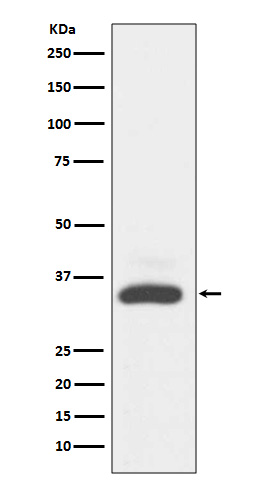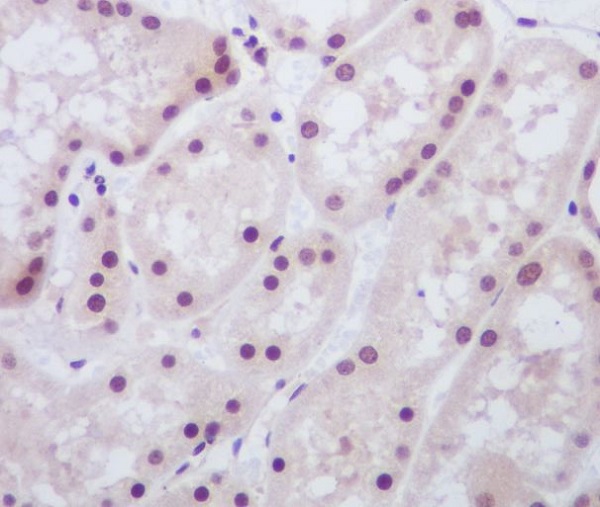

| WB | 1/1000-1/2000 | Human,Mouse,Rat |
| IF | 咨询技术 | Human,Mouse,Rat |
| IHC | IHC:1/100-1/200;IHF:1/50-1/200 | Human,Mouse,Rat |
| ICC | 1/50-1/200 | Human,Mouse,Rat |
| FCM | 咨询技术 | Human,Mouse,Rat |
| Elisa | 咨询技术 | Human,Mouse,Rat |
| Aliases | Caught by MAD2 protein; CMT2; KIAA0110; MAD2L1 binding protein; MAD2L1-binding protein; MAD2L1BP; MD2BP; MGC11282; RP1-261G23.6;;MAD2L1BP |
| WB Predicted band size | Calculated MW: 31 kDa ; Observed MW: 34 kDa |
| Host/Isotype | Rabbit IgG |
| Antibody Type | Primary antibody |
| Storage | Store at 4°C short term. Aliquot and store at -20°C long term. Avoid freeze/thaw cycles. |
| Species Reactivity | Human,Mouse,Rat |
| Immunogen | A synthesized peptide derived from human MAD2L1BP |
| Formulation | Purified antibody in PBS with 0.05% sodium azide,0.05% BSA and 50% glycerol. |
+ +
以下是关于MAD2L1结合蛋白抗体的3篇参考文献,按文献名称、作者和摘要内容概括列出:
---
1. **文献名称**:*p31comet拮抗MAD2依赖性纺锤体检查点的分子机制*
**作者**:Sudo, H., et al.
**摘要**:本研究通过免疫共沉淀和抗体阻断实验,发现p31comet通过竞争性结合MAD2L1破坏其与CDC20的互作,从而调控有丝分裂检查点的失活。研究证实了针对MAD2L1结合结构域的抗体的特异性功能验证作用。
2. **文献名称**:*BUBR1-MAD2L1复合物在结直肠癌中的异常表达及临床意义*
**作者**:Wang, Z., et al.
**摘要**:利用抗MAD2L1和BUBR1的特异性抗体,作者发现二者形成的复合物在结直肠癌组织中显著高表达,且与患者预后不良相关。抗体被用于免疫组化及Western blot分析复合物的稳定性。
3. **文献名称**:*MAD2L1结合蛋白抗体在卵巢癌细胞有丝分裂停滞中的功能筛选*
**作者**:Thompson, J.R., et al.
**摘要**:通过高通量siRNA联合抗MAD2L1相互作用蛋白抗体的筛选,鉴定了多个调控纺锤体检查点的新靶点,揭示了抗体在活细胞成像中追踪MAD2L1动态结合的潜力。
---
以上文献均聚焦于MAD2L1结合蛋白抗体的应用,涵盖机制研究、疾病关联及技术方法开发。如需扩展至4篇,可补充针对特定癌症亚型的研究(如乳腺癌中MAD2L1/TPX2复合物的抗体检测)。
The MAD2L1-binding protein antibody is a crucial tool for studying the spindle assembly checkpoint (SAC), a surveillance mechanism ensuring accurate chromosome segregation during mitosis. MAD2L1 (Mitotic Arrest Deficient 2-Like 1) is a core SAC component that binds to kinetochores unattached to spindle microtubules, forming the Mitotic Checkpoint Complex (MCC) with BUBR1. CDC20. and other proteins. This complex inhibits the anaphase-promoting complex/cyclosome (APC/C) until all chromosomes achieve proper attachment, preventing premature anaphase onset.
Antibodies targeting MAD2L1 or its binding partners (e.g., MAD1. CDC20) are widely used to investigate SAC dynamics, chromosome missegregation, and genomic instability. They enable detection of protein-protein interactions via co-immunoprecipitation, localization studies using immunofluorescence, and quantification via Western blotting. Dysregulation of MAD2L1 or its interactors is linked to aneuploidy and tumorigenesis, making these antibodies valuable in cancer research. For example, reduced MAD2L1 expression correlates with aggressive cancers, while overexpression may drive chemoresistance.
These reagents also aid in studying SAC-targeting therapies and mechanisms underlying developmental disorders linked to chromosomal instability. Specificity and validation (e.g., knockout cell controls) are critical, as off-target binding can obscure SAC-related phenotypes. Overall, MAD2L1-binding protein antibodies are indispensable for dissecting cell cycle regulation and its pathological disruptions.
×